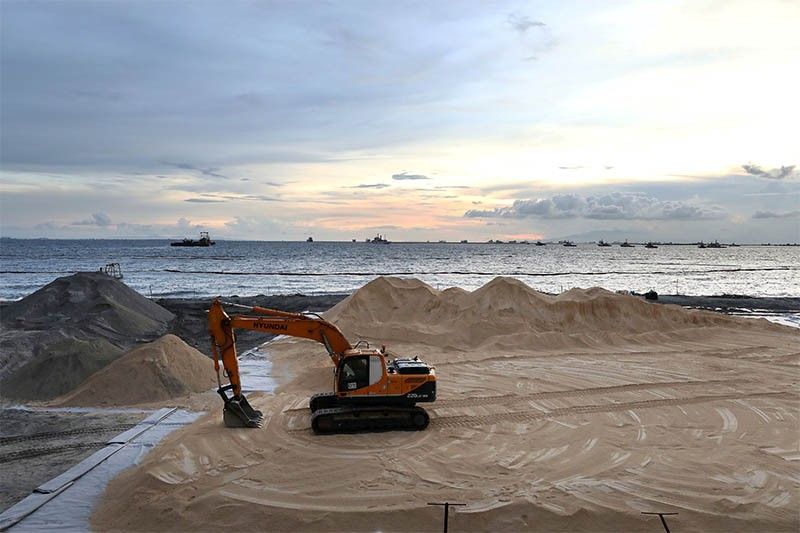About prescribing epoxy for a case of internal bleeding
Hundreds of thousands of people watched a video of a boy in a pink polo, staring at a photo of Manila Bay’s dolomite sand beach with his hands clasped. This curious livestream posted by independent musician Cloud, titled “Staring at white sand until my mental health is okay” went viral on Facebook after being posted on Sept. 29, 8:05 p.m.
As of this writing, the 306-minute long video has garnered over 879,000 views, and 38,000 reactions. Whether or not a social media post goes viral is subject to a multitude of factors beyond an individual’s control, like inscrutable algorithms and volatile user interactions. Sometimes you just have to be in the right place at the right time.
This video emerged when the Manila Bay was trending on social media after the most recent development in its rehabilitation: the dumping of dolomite sand mined from Cebu, reportedly to the tune of around P389 million. A deluge of memes under the #ManilaBayChallenge hashtag satirized the high cost of the endeavour, which could have otherwise been channeled into pandemic response amidst the national health crisis. “Staring at white sand” stood out above the rest for its distinctly contemporary approach.
The video’s 32,000 comments, many of which accumulated during the livestream itself, are as internet as the internet can be. The comments range from expressions of care from concerned friends, tongue-in-cheek memes, direct reactions in support of and against the Manila Bay rehabilitation project.
As a video in itself, it shares a kindred approach with avant-garde cinema and durational performance art. Take Andy Warhol’s avant-garde films Eat (1963), Kiss (1963), Sleep (1964), Blow Job (1964) and Empire (1964). Aside from cinema, Cloud’s livestream could be said to draw from Marina Abramovic’s The Artist is Present (2010), which turned the body into the performance object. Bea Camacho’s and Rene Aquitania’s durational performances that have delved into the embedded relationship between the human and the environment. While Warhol’s flicks and Abramovic’s performance both concern themselves with the passing of time, even if this livestream is similarly static and meditative, how this is engaged with is drastically different because it’s on Facebook.
There are, of course, individuals scrutinizing whether the artist truly sat for five hours, or created a video loop. But I don’t think the distinction matters considering that content on social media is inherently performative. The execution carries over the artist’s intention.
Social media, which has been designed to give its users an endless flow of information at a breakneck speed, presents a challenge to artists about how to keep a viewer’s attention on a singular object. “Staring at white sand until my mental health is okay” doesn’t demand your full attention as a viewer fixating on a singular video; it embraces the nature of how people naturally use social media, and the various forms of engagement this initiates. You can watch it for as long or as short as you want. You could comment, share, and revisit the video after a couple of hours to see how it has evolved. Or you could view it for a few seconds before scrolling up. Each mode of reception is valid, and any work on the internet has to embrace how the platform it’s on will determine how it is engaged with — and anyone user interface designer is familiar with this all too well.

Ironically, this also means that as soon as I’ve written this down and articulated it, the collective audience has moved onto the next fruit falling from the proverbial algorithm tree. But this approach to art and performance is happening outside of white cubes and conventional spaces, and it’s an articulation familiar to a generation who has grown up with the internet as a part of life. “Staring at white sand until my mental health is okay” is memorable because it works due to, and not in spite of, being on the world wide web.
Obviously, staring at a photo of industrial debris masquerading as Boracay isn’t going to solve mental health issues, which is also a health crisis that the pandemic has exacerbated. We’re now a viewer watching a viewer, watching a project that is symptomatic of an approach that is as effective as giving a bandage to a person with a kidney stone or perhaps prescribing epoxy to a person with an acute case of internal bleeding.
Real life remains more absurd than memes, more often than not. Cloud’s video has certainly outlasted the white sand beach topic itself. It’s one of the multitude of expressions of rage and indignance in an era that tests the most stubborn of resolve, but is certainly not enough to collectively triumph over the worst of our collective physical, historical and societal ailments.



